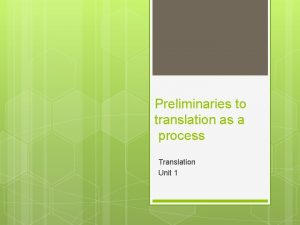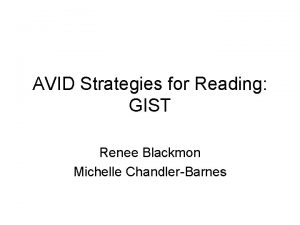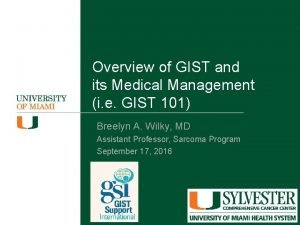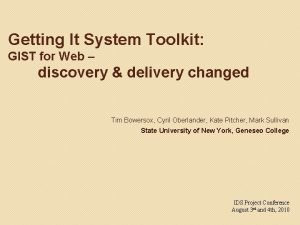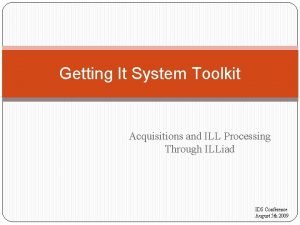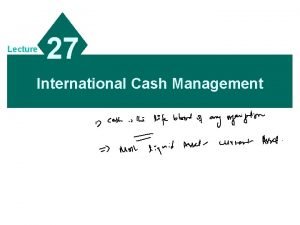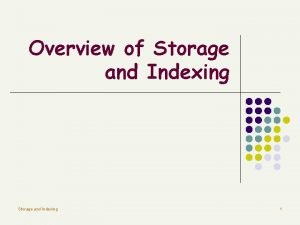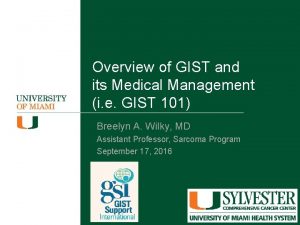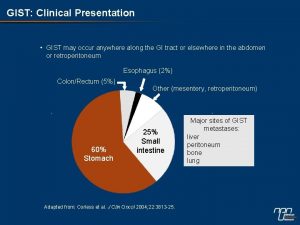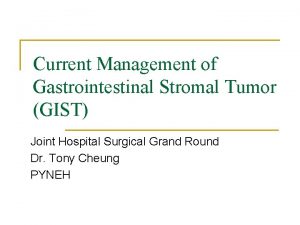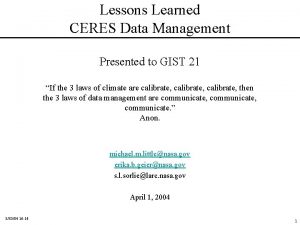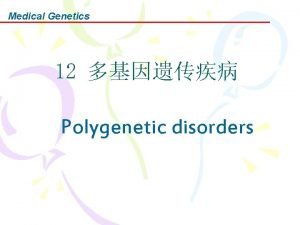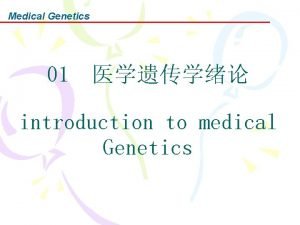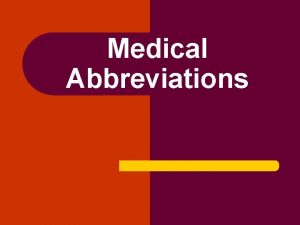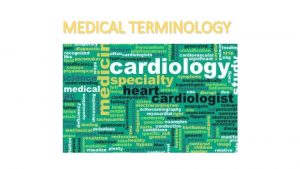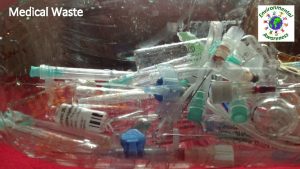Overview of GIST and its Medical Management i













































- Slides: 45

Overview of GIST and its Medical Management (i. e. GIST 101) Breelyn A. Wilky, MD Assistant Professor, Sarcoma Program September 17, 2016

OVERVIEW • What is GIST? • How do we treat GIST? • How do we use imatinib (Gleevec) in GIST? • What are the options for imatinibresistant GIST? • How do we manage side effects of imatinib?

What is GIST? • Gastrointestinal stromal tumor, the most common type of sarcoma • A tumor of the interstitial cells of Cajal (ICC) • Can occur at any point in the digestive organs, including stomach (most common), small intestine, large intestine, and rectum Figure from Section VI, Gastrointestinal Physiology (Ginsburg, J. M. and Costoff, A. in Essentials of Human Physiology (edited by Nosek, T. M. ),

Why do GISTs grow? • 80% of GISTs have a mistake (mutation) in the genetic code that results in a hyperactive KIT protein (light-switch ON) • We recommend that patients have their tumor mapped (called sequencing) to determine which exon has the mutation • Up to 20% of GISTs may have a mistake in a NON-KIT gene – important for treatment!!! (more later) KIT: Extracellular Domain (exon 9, 10. 2%) Growth signals (outside) ↓ KIT receptor Juxtamembrane Domain ICC (exon 11, 66. 1%) ↓ Growth signals Tyrosine Kinase Domain I (inside) (exon 13/14, 1. 2%) KIT ATP KIT Tyrosine Kinase Domain II (exon 17, 0. 6%) = common mutation site

Who gets GIST? • Overall, only about 5000 new GISTs per year • Most common in 40 -60 year old patients, similar rates in men and women • Gastrointestinal symptoms of GIST include pain, nausea, lack of appetite, bleeding. • Incidental findings in endoscopy • Very rarely, a special type of GIST can be passed down in families or occur in children • No known risk factors Photo from Wikipedia

How do we treat GIST? • LOCAL vs. SYSTEMIC treatment • Surgery is the goal! (Complete removal of the GIST) • GISTs are relatively resistant to radiation • Metastases – spread of the tumor cells to the liver, or inside the abdomen (peritoneal disease), less common to lung, bone, etc. • Most recurrences happen within 2 years of the surgery

Risk determination in GIST • How likely is it that the GIST will come back after removal by surgery? • GISTs are classified into LOW risk, INTERMEDIATE risk, and HIGH risk based on: • Size (less than 5 cm, 5 -10 cm, or greater than 10 cm) • Location (gastric vs other sites) • Mitoses (a measure of the speed of growth in the cells) Estimated chance of recurrence/metastasis: GASTRIC (stomach) OTHER (intestine, etc) < 5 mitoses > 5 mitoses < 5% 12 -15% < 5% 50 -70% 5 -10 cm < 5% 55% 25% 70 -90% > 10 cm 12 -15% 86% 30 -60% 70 -90% < 5 cm Adapted from NCCN guidelines, from Miettinen M, Lasota J. Sem Diagn Pathol 2006.

Uses of systemic treatment in GIST • To prevent the recurrence or metastasis after surgery in high-risk GIST patients • To shrink a GIST tumor that cannot be removed completely by surgery at the time it is found. (it is in a bad spot…) • To control GIST that has already spread to other organs or inside of the abdominal cavity (peritoneal disease)

Systemic treatment in GIST Old-school chemotherapy in advanced GIST

The role of imatinib in GIST • Imatinib is an oral chemotherapy drug • Binds to the ATP-binding site and blocks the downstream signaling to the cell from hyperactive KIT • Works best in exon 11 mutated GIST, other mutation sites tend to be more resistant KIT: Extracellular Domain (exon 9, 10. 2%) Juxtamembrane Domain (exon 11, 66. 1%) Tyrosine Kinase Domain I (exon 13/14, 1. 2%) ATP Imatinib Tyrosine Kinase Domain II (exon 17, 0. 6%) = common mutation site

Schematic Structures of KIT and PDGFRA ATP-binding Domain Activation Loop Modified from Heinrich et al. http: //dx. doi. org/10. 1200/JCO. 2003. 04. 190

Schematic Structures of KIT and PDGFRA ATP-binding Domain Sunitinib Activation Loop Regorafenib Modified from Heinrich et al. http: //dx. doi. org/10. 1200/JCO. 2003. 04. 190

GIST Subtypes • Kit mutation ~80% of GISTs • PDGFR mutation ~10% of GISTs • • SDH-B deficient Raf V 600 E NF-1 Ras PI 3 K IGF-1 R overexpressed TRK fusion “wild-type” Exon 11 (~70%): codon 557 -558 (risky) Exon 9 (~10%) Exon 13/14 (~1%) resistant Exon 17 (<1%) resistant Exon 12 Exon 18 D 842 V (resistant)

The First GIST Patient: Histology H&E (at diagnosis) H&E Ki 67 CD 117 Pretreatment One month of therapy Joensuu H et al. N Engl J Med. 2001; 344: 1052 -1056.

CT response in GIST Post-Imatinib (8 weeks therapy)


“Pseudoprogression” in GIST 1/18 3/23 1/26 3/22 10/8

How do we treat GIST? • Adjuvant therapy with imatinib • Use after surgery to prevent the GIST from coming back when there is NO visible evidence of remaining tumor. • Routinely recommended for high risk patients, and many intermediate risk patients • Optimal length of treatment still under investigation…

ACOSOG Z 9001 Adjuvant therapy • 1 -year RFS 98% - Imatinib 400 mg • 1 -year RFS 80% - Placebo • Recurrence in imatinib arm increases at 18 months (6 months following discontinuation of therapy) 713 patients KIT+ > 3 cm • RFS was significantly improved in Imatinib arm in each tumor size category but greatest for tumors > 10 cm (De. Matteo et al, 2009)



SSG XVIII How long should we continue imatinib? • Prospective, open-label, phase III trial • 400 patients with operable primary GIST • >5 cm, >5 mitoses/50 HPF • Based on this study, standard duration is three years, but ongoing trial is investigating five year treatment (PERSIST 5). • At 3 year mark, only 4 / 91 patients have recurred (1 with resistant mutation, 3 after discontinuing imatinib. ) • Maybe longer…? 36 months 12 months Imatinib (400 mg/day) N = 200 5 -year RFS Imatinib 66% Imatinib 48% P < 0. 0001 5 -year OS Imatinib 92% Imatinib 82% P = 0. 019 SSG XVIII, Joensuu H et al. ASCO 2011, ASCO 2015 abstract 10537, Raut et al.

How do we treat GIST? Neo-adjuvant therapy with imatinib • Shrink/liquefy the tumors so complete resection with surgery is possible • Consider for • Unresectable/borderline resectable tumors • Tumors requiring extensive resection of involved organs • Potentially resectable metastatic GIST • Controversial – multidisciplinary evaluation required • Important steps – • sequencing to determine mutation - Is it likely to respond to imatinib? • Get accurate imaging at baseline, including a PET, as PET may show response to treatment even if size doesn’t change. RTOG = Radiation Therapy Oncology Group ; ACRIN = American College of Radiology Imaging Network Van den Abbeele et al. , J Nucl Med 2012; 53: 1– 8. ; Eisenberg B et al. J of Surgical Oncology 2008.

Neoadjuvant imatinib RTOG 0132 -ACRIN 6665 63 patients Group A, localized (n=30) Group B, metastatic (n=22) Response 7% PR, 83% SD, 10% unk 4. 5% PR, 91% SD, PD 4. 5% Estimated 2 -year PFS 82. 7% 77. 3% Estimated 5 -year PFS 57% 30% Estimated 2 -year OS 93. 3% 90. 9% Estimated 5 -year OS 77% 68% Type of Resection R 0 R 1 R 2 77% 15% 8% R 0 R 1 R 2 Unspecified 58% 5% 32% 5%

How do we treat GIST? Treatment of metastatic disease with imatinib • Goal is to neutralize the existing tumor and prolong the time to progression • Progression on a treatment occurs when some of the cells in the tumor develop resistance to the drug, and begin growing (can be regrowth of a previous tumor, or the development of a new tumor) • Most commonly, the resistant cells that remain have a different or additional mutation that makes them resistant to the imatinib • Sometimes this can be overcome by increasing the imatinib dose

Imatinib for metastatic/unresectable GIST • Combined data from two large trials (1640 patients) with metastatic or advanced GIST • Treated with imatinib at either 400 mg or 800 mg • Median time to progression 1. 58 yrs on the 400 mg arm, 1. 95 yrs on the 800 mg arm, 30 -35% free from progression at 3 years • Significant benefit to 800 mg only in exon 9 patients Gastrointestinal Stromal Tumor Meta-Analysis Group (Meta. GIST). J Clin Oncol. 2010.

Length of treatment in metastatic GIST • Ok, my GIST now has shrunk or stabilized – how long do I need to stay on imatinib? • Can I take a break from imatinib or will my tumors start to grow again? • Does staying on imatinib longer help prevent the GIST from developing resistance?

BFR 14 Advanced/ metastatic GIST 434 patients R A N D O M I S A T I O N Imatinib 400 mg Imatinib for 1 year PD STOP Imatinib for 3 years Imatinib for 5 years Imatinib 400 mg 71 patients without progression

BFR 14 • Patients who progressed were restarted on imatinib, and 94% of patients had tumors respond again to imatinib. • BUT – in patients who got CR initially, only 41. 7% achieved it again with rechallenge, and in patients with PR, only 56% were able to achieve it again. Development of resistance? Continued imatinib Stopped imatinib Imatinib 1 year 8/26 PD PFS 18 mos 26/32 PD PFS 6. 1 mos Imatinib 3 year 7/25 PD 1 yr PFS 92% 21/25 PD 1 yr PFS 32% Imatinib 5 year 0/10 PD (at 1 year) 5/11 PD (at 1 year) • Our practice – DON’T STOP! Blay JY et al, JCO 2007 Le Cesne A, et al, Lancet Oncol 2010 Ray-Coquard IL, ASCO 2010, abst 10032 Patrikidou et al, Annals Oncol 2012 Blay et al, Annals Oncol 2011

Putting it all together… so far? • Intermediate and high risk GISTs are likely to leak cells out into the abdomen which can lead to recurrence and metastasis, even if the initial tumor is completely removed • The use of imatinib can result in rapid, dramatic tumor shrinkage, and is often underappreciated with traditional interpretation of CT scans. • If possible, surgical removal of tumors appears to improve the outcome, even if the GIST has already spread. Multidisciplinary evaluation with sarcoma surgeons is critical. • Imatinib can control the growth of resistant cells for years, but when stopped, these cells often begin growing again. • Unfortunately, most GIST tumors ultimately will progress despite imatinib therapy and we require new drugs that are effective against imatinib-resistant cells. • Until we have new drugs that can KILL all of the GIST cells up front, the best defense is to use imatinib as a maintenance medication as long as possible for high-risk or metastatic tumors

Type of Progression Limited progression Nodular progression Stable lesion Progressing lesion disease Widespread progression

Secondary mutations KIT: Extracellular Domain (exon 9, 10. 2%) Juxtamembrane Domain (exon 11, 66. 1%) Tyrosine Kinase Domain I (exon 13/14, 1. 2%) ATP Imatinib Tyrosine Kinase Domain II (exon 17, 0. 6%) Gramza et al. Clin Cancer Res 2009; 15: 7510 -7518

Options if imatinib-resistant • Limited or Nodular Progression – Ablations (chemo, freeze, burn, electrocute…) – Surgical Resection – Radiation (including stereotactic Cyberknife) • Widespread progression – – – Consider sequencing or re-biopsy Increase Imatinib to 800 mg daily Sunitinib, Regorafenib Clinical trial Other tyrosine kinase inhibitors Stable Progressing lesion Kobayashi K, et al. Am J Clin Oncol. 2009; 32: 574 -581.

Phase III Trial TIME TO TUMOR PROGRESSION Demetri GD et al. Lancet. 2006; 368: 1329 -1338.

Progression-free Survival Comparison of Central Review vs Investigator Assessments Regorafenib (N=133) (investigator assessment) (central review) Regorafenib Survival distribution function 1. 00 Placebo (central review) 0. 75 PFS 4. 8 vs 0. 9 months (p<0. 0001) 0. 50 0. 25 0 0 50 100 150 200 Days from randomization Casali PG, Reichardt P et al. Presented at: ESMO 2012; abstract 1478 O. 250 300 350

Other Agents for Imatinib-Resistant GIST CLASS AGENT TRIAL PHASE RESULTS Sorafenib II PR=13%, SD=58% PFS=5 months Dasatinib II PR=22%, SD=24% PFS= 2 months Nilotinib I/II/III PR=10%, SD=37% PFS=3 months Pazopanib II SD=48% PFS=1. 9 months SDH-17 cycles Axitinib ND ND Crenolanib, BLU-285 III, I CBR 31%, 56% PFS>6 months Vemurafenib I ND m. TOR Inhibitors Everolimus II/III PR=2%, SD=43% PFS=3. 5 months PI 3 K Inhibitors Buparlisib (BKM 120) I/II Recruiting HDAC inhibitors Vorinostat NA ND Various III PR=0% PFS=1 - 1. 5 months KIT Inhibitors PDGFR inhibitors (D 842 V) Raf Inhibitors Placebo HDAC=histone deacetylase; IGF-1 R=insulin-like growth factor– 1 receptor; MKI=multitargeted kinase inhibitor; m. TOR=mammalian target of rapamycin.

Life with imatinib • Tyrosine kinase inhibitors – Block RECEPTORS on the surface of cells – Dirty drugs – The idea is that a particular receptor and its chain-ofcommand are MORE active in the cancer cell compared to a normal cell – but all cells have these receptors – Thus, while killing the cancer, non-cancer cells will also experience disruptions in their normal way of life = side effects (on-target effects)

Drug interactions • Imatinib is meant to be taken with food and water – (taking on an empty stomach leads to LESS exposure to the active drug, or undertreatment!) • Prohibited medications and juices/supplements (lead to increased levels of imatinib with worse side effects) – St. Johns Wort – Grapefruit juice – Star fruit, pomegranate juice – Coumadin – Can increase levels of cholesterol and blood pressure medications- check with your doctor – Tylenol, alcohol – stresses the liver – Iron supplements, changes absorption

Most common side effects • • • Swelling/fluid retention, often around the eyes Nausea/vomiting/abdominal discomfort Loss of appetite Fatigue Muscle/bone/joint aches and pains Diarrhea Rashes and other skin issues Mild blood count abnormalities Mild electrolyte abnormalities

Dangerous side effects (call right away) • New or sudden shortness of breath, especially at rest, or associated with new or worse swelling in the legs • Chest pains • Yellowing of the skin/eyes (liver abnormalities) • Severe headache • Foamy urine

Special side effects for Sunitinib (Sutent), regorafenib (Stivarga), and pazopanib (Votrient) • • • High blood pressure – almost everyone Bleeding and clots Yellowish or pale skin, hair and nails Watch that thyroid and liver! Hand-foot syndrome

Management tricks Side effect Management Fluid retention/swelling Daily weights – salt intake – diuretics – massage – support stockings Nausea/vomiting/ abdominal pain Anti-emetics – change time of day – take with food – small frequent meals - liver – small frequent meals – watch interacting meds - Fatigue Rule out contributing causes - Prioritize activities – water – sleep/stress/exercise- meds Aches and pains Hydration – electrolytes – exercise – ivory soap – avoid OTC pain meds – Lidoderm patches/hot/cold Diarrhea Food diary – small frequent bland meals – yogurt – water - meds Loss of appetite Awareness – anti-emetics – high calories – grazing – supplements meds Rashes/skin issues Variable types – sun – mouth sores – moisturizer/friction – antihistamines/steroids/antibiotic – drug holiday Labs to watch CBC - Liver – Kidneys - Thyroid (especially long term)

What about generic imatinib? • Patent expired for CML, not GIST, but generics are now available • Generic companies required to prove bioequivalence, but not therapeutic equivalence • Usual concerns with different side effects based on fillers as with any generic • Brand-name only assistance programs Good source of info - https: //liferaftgroup. org/generics/

Take-home recommendations • Know about GIST – Foundation websites, Days of Learning, forums • Know about your own GIST – Customize treatment based on the mutations and distribution of tumors (Dr. Trent’s talk!) • Know your options – Seek second opinions with GIST experts who are up-to-date on the newest drugs, clinical trials, science and research.

Thank you for coming today! GIST 101 Questions? ? ? Breelyn A. Wilky, MD Email: b. wilky@med. miami. edu Blog: breelynwilkymd. com
 Gist strategy
Gist strategy Gist translation examples
Gist translation examples Maus chapter 1 summary
Maus chapter 1 summary What is a 20 word gist
What is a 20 word gist George gist
George gist To kill a mockingbird chapter 3-5 summary
To kill a mockingbird chapter 3-5 summary Gist tumor lebenserwartung
Gist tumor lebenserwartung Gist
Gist Gist review
Gist review What is the gist of pages 6-12 in unbroken
What is the gist of pages 6-12 in unbroken Chapter 14 medical overview
Chapter 14 medical overview The emigree poem
The emigree poem Its halloween its halloween the moon is full and bright
Its halloween its halloween the moon is full and bright Hepburn osteometric board
Hepburn osteometric board Introduction to content management
Introduction to content management Intro to hrm
Intro to hrm Management topics for project
Management topics for project Gym management dashboard
Gym management dashboard Real time interaction management forrester
Real time interaction management forrester Gambaran
Gambaran Management overview
Management overview Overview of financial management
Overview of financial management What is multinational financial management
What is multinational financial management Chapter 1 an overview of financial management
Chapter 1 an overview of financial management An overview of financial management
An overview of financial management When a train increases its velocity, its momentum
When a train increases its velocity, its momentum Cloudy sunny rainy windy
Cloudy sunny rainy windy If its a square it's a sonnet summary
If its a square it's a sonnet summary Its not easy but its worth it
Its not easy but its worth it Ptal california medical board
Ptal california medical board Greater baltimore medical center medical records
Greater baltimore medical center medical records Torrance memorial cardiac rehab
Torrance memorial cardiac rehab Cartersville medical center medical records
Cartersville medical center medical records Management and its functions
Management and its functions International cash management definition
International cash management definition Perbedaan replikasi virus dna dan rna
Perbedaan replikasi virus dna dan rna Data cleaning problems and current approaches
Data cleaning problems and current approaches The two rows of elements that seem to be disconnected
The two rows of elements that seem to be disconnected Chicago time
Chicago time What is bioinformatics an introduction and overview
What is bioinformatics an introduction and overview An overview of data warehousing and olap technology
An overview of data warehousing and olap technology Data quality and data cleaning an overview
Data quality and data cleaning an overview Data quality and data cleaning an overview
Data quality and data cleaning an overview Overview of storage and indexing
Overview of storage and indexing Chapter 17 overview elements and their properties
Chapter 17 overview elements and their properties Pyramid levels of management
Pyramid levels of management

